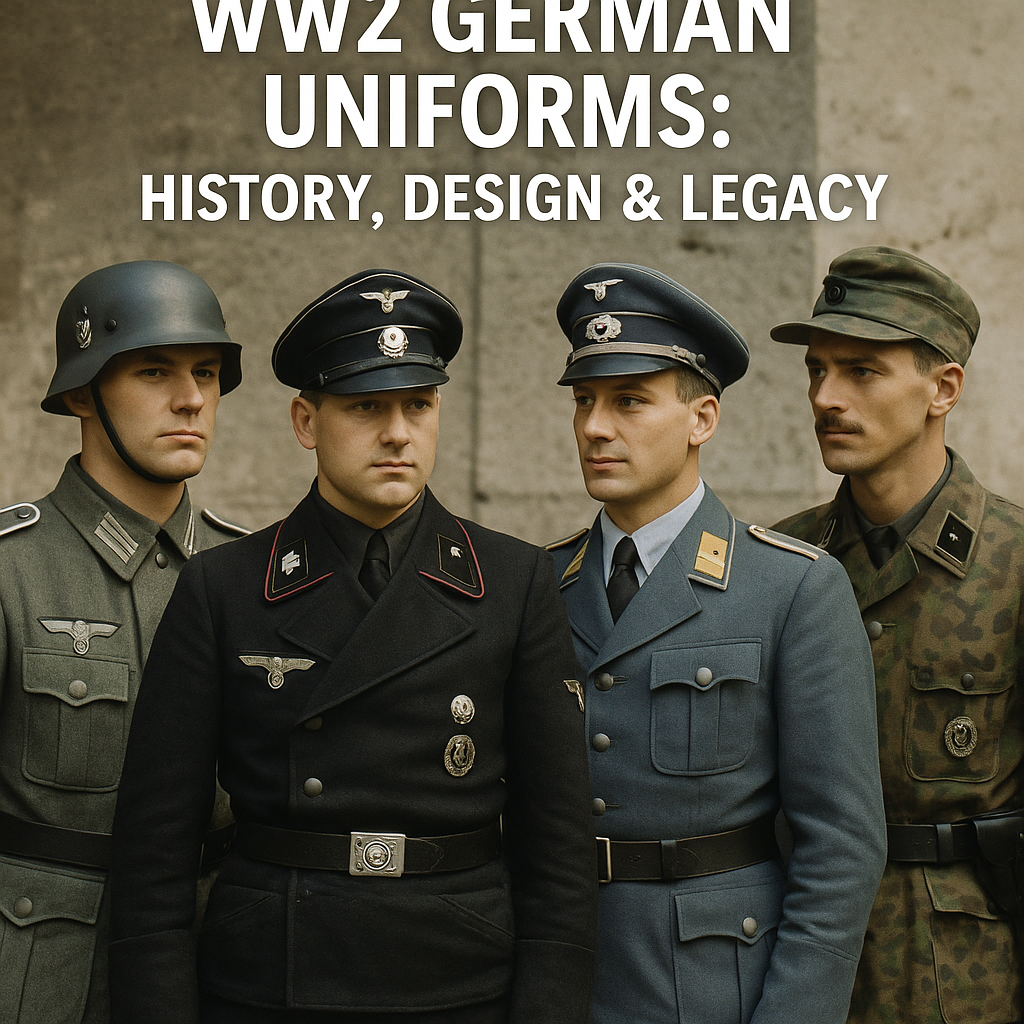
Inside the Iconic WW2 German Uniforms: History, Design & Legacy
Published on Jun 29, 2025
Inside the Iconic WW2 German Uniforms: History, Design & Legacy
When you think of military uniforms from the Second World War, few are as instantly recognizable as those worn by the German forces. From the sharp-cut field gear of the Wehrmacht to the black-clad SS, WW2 German uniforms reflect a blend of military tradition, engineering, and propaganda.
At Paddelaters, we specialize in sourcing and reproducing historically accurate war-related uniforms for collectors, historians, and reenactors. In this detailed guide, we’ll explore the origins, categories, symbolism, and ongoing interest in WW2 German uniforms—perfect for those seeking insight or collecting tips.
1. Origins of WW2 German Uniform Design
Before diving into types, it’s important to understand the foundations of German military fashion. The German military had a long tradition of distinct and sharp uniforms that predated the Nazi era. The WW2 uniform styles were influenced heavily by those used during World War I, with updates for practicality, climate, and technological change.
The Nazis also understood the power of visuals. Uniforms were designed not just for function but for fear and symbolism. They aimed to create a sense of unity, discipline, and intimidation.
2. Key Types of WW2 German Uniforms
German WW2 uniforms varied significantly depending on military branch, rank, and function. Here's a breakdown of the most iconic categories:
a) Wehrmacht (Heer) Uniforms
The Wehrmacht, or German Army, made up the largest part of the German military. Their base uniform included:
- M36 Field Blouse (Feldbluse): Wool tunic with dark green collar and four front pockets.
- M40 & M43 Upgrades: Simplified versions to conserve resources.
- Field Gray Color (Feldgrau): A unique green-gray shade used for camouflage.
- Insignia: Breast eagles, shoulder boards, and collar tabs signified rank and division.
These uniforms were often paired with jackboots early in the war, later replaced by ankle boots and gaiters due to material shortages.
b) Waffen-SS Uniforms
The Waffen-SS had their own production line for uniforms, often marked by a darker field gray or even black clothing in early years.
Key differences included:
- SS Runes on Collar Tabs
- Camouflage Smocks (Zeltbahn): Used for concealment in combat.
- Reed Green Summer Uniforms
- SS Dot Pattern Camo: A distinct design still referenced in modern tactical gear.
The SS uniforms were intentionally designed to be intimidating, aligning with their elite status.
c) Luftwaffe Uniforms
Germany’s air force, the Luftwaffe, had uniforms designed for both flight and ground operations. Common features included:
- Blue-gray tunics
- Flight suits and leather jackets for pilots
- Paratrooper (Fallschirmjäger) Uniforms with jump smocks and unique helmets
d) Panzer (Tank) Uniforms
Panzer crews needed compact, flexible uniforms for cramped tank interiors:
- Black Wool Uniforms: Symbolizing oil stains and danger.
- Skull Insignia (Totenkopf): On the collar as a legacy from WWI tank crews.
- Wrap-Around Tunics: Designed for practicality during tank operations.
3. Rank Insignia & Badges
German uniforms were richly decorated with:
- Iron Crosses
- Knight’s Crosses
- Campaign Shields
- Eagle & Swastika Breast Emblems
- Shoulder Boards to denote ranks (Gefreiter, Unteroffizier, Oberleutnant, etc.)
These additions were not merely decorative—they played a role in chain-of-command visibility in chaotic combat situations.
4. Field Gear & Accessories
No uniform was complete without its field gear. German soldiers were equipped with:
- Y-Straps and Bread Bags
- Gas Mask Canisters
- Mess Kits (Kochgeschirr)
- Bayonets and Entrenching Tools
- Helmet Covers with Camouflage Patterns
Helmets, or Stahlhelms, came in several variants (M35, M40, M42) and are still highly collectible today.
5. Evolution Throughout the War
As the war dragged on, Germany faced resource shortages. This was reflected in their uniforms:
- Simplified Production: Fewer details, cheaper buttons, blended fabrics.
- Use of Foreign Labor: Uniforms were sometimes manufactured in occupied territories.
- Winter Gear: The Eastern Front required padded parkas, fur-lined boots, and gloves, often in white for snow camouflage.
6. Symbolism and Psychological Impact
Uniforms served more than just utility. Hitler and the Nazi party knew the psychological impact of strong visual branding:
- Black SS Uniforms: Designed by Hugo Boss, aimed to intimidate and project power.
- Swastika Armbands: Highly symbolic of the regime.
- Sharp Cuts and Form-Fitting Styles: Reinforced discipline and unity.
This branding played a massive role in propaganda and the Nazi image machine.
7. Why WW2 German Uniforms Remain Popular Today
At Paddelaters, we see consistent interest in WW2 German uniforms. Why?
- Historical Research: Museums and historians use them to study combat history.
- Reenactments: Historical reenactors rely on accurate uniforms to tell authentic stories.
- Collectibles: Original pieces, especially officer tunics and rare camo, are valuable.
- Film and TV: Authentic costuming for war dramas and documentaries.
- Military Surplus Enthusiasts: Appreciate the engineering and resilience of these garments.
8. Collecting & Reproductions: What to Know
Authentic WW2 German uniforms can fetch thousands, but there are also high-quality reproductions.
Things to consider:
- Condition & Originality: Look for original stitching, markings, and stamps.
- Reproduction Value: Good reproductions can still hold value if made accurately.
- Legality: In some countries, Nazi symbols are restricted. We always recommend researching your local laws.
At Paddelaters, we offer both historically accurate reproductions and guidance for collectors looking to start or expand their collection.
Final Thoughts
WW2 German uniforms tell a complex story of military innovation, propaganda, and legacy. Whether you're a collector, reenactor, or history enthusiast, understanding these uniforms opens up a new dimension of WW2 history.
From the sleek design of the SS to the rugged practicality of Wehrmacht field gear, these garments represent both history and craftsmanship. As interest in military history grows, so too does the appreciation for these iconic pieces of the past.
